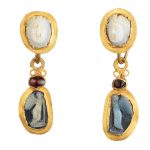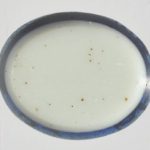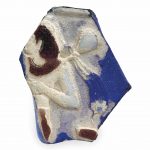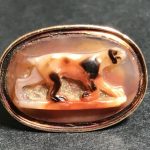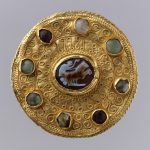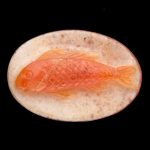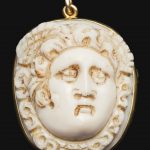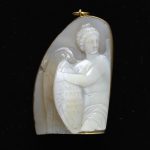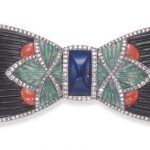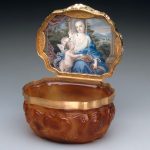Roman cameos and cameo glass are not only beautiful items but also tell us the history of the Romans through art. The Romans were highly proficient in cameo glass making and the carving of gemstones.
Roman cameos would often show depictions of gods and goddesses, animals and emperors. All of these give us an incite into the beliefs and people or animals of importance during the Roman Empire.
Throughout history, Roman cameos have been found their way into more modern items of jewellery and settings. This can be seen by the disk brooch below which has a later setting created by the Langobards.
Roman oval fragment of blue and white cameo glass, two layers; from a total of ninety-five glass fragments
Reference: © The Trustees of the British Museum
A ROMAN CAMEO GLASS FRAGMENT OF A PHARAOH CIRCA SECOND HALF OF 1ST CENTURY A.D. 1 ¼ in. (3.2 cm.) high
Sold for USD 7,500 at Christies in 2018
Roman agate cameo ring of a dog, set in modern 14k gold mounting. Size 4, 4.5 dwts.Circa 2nd century AD.A wonderful example of Greek and Roman hardstone cameo carving.The dog is a pointer or bloodhound type, with the dark spots in the matrix of the stone being used as the dark spots on the dog’s ear and fur.
Sold for $800 at David Killen Gallery in 2018
Disk Brooch with Cameo Date:ca. 600 (mount); 100–300 (cameo) Culture:Langobardic (mount); Roman (cameo)
The Langobards often embellished their own jewelry with gems carved centuries earlier by Roman or Etruscan craftsmen. These gems, valued for their antiquity, linked their Langobardic wearers to the illustrious peoples who preceded them on the Italian peninsula.
Reference: The Metropolitan Museum of Art
Cameo with fish Roman Imperial Period 1st century
Oval carnelian cameo with white background. Fish (red mullet) to left
Reference: Museum of Fine Arts Boston
Fragment of a large chalcedony cameo depicting the winged figure of Nike grasping her shield. The figure is present from the mid-thighs up, the upper part of her body naked and her hair dressed on top of her head. She strides to the left and turns her head to the right. Mounted in a plain gold band round the edges with a ring for suspension.
This fragment is all that remains of what would have been a much larger cameo made to celebrate an important Roman imperial victory. The figure is Nike, the Roman goddess of victory. The inscription on her shield, which may have been added after the cameo was carved, refers to the emperor Trajan’s conquest of Dacia and acquisition of Arabia in AD 106. In a cameo, the image stands proud of the surface. Large and important pieces like this one were produced by highly skilled Roman cameo engravers and prized by their owners as symbols of status and power.
Reference: © Victoria and Albert Museum
